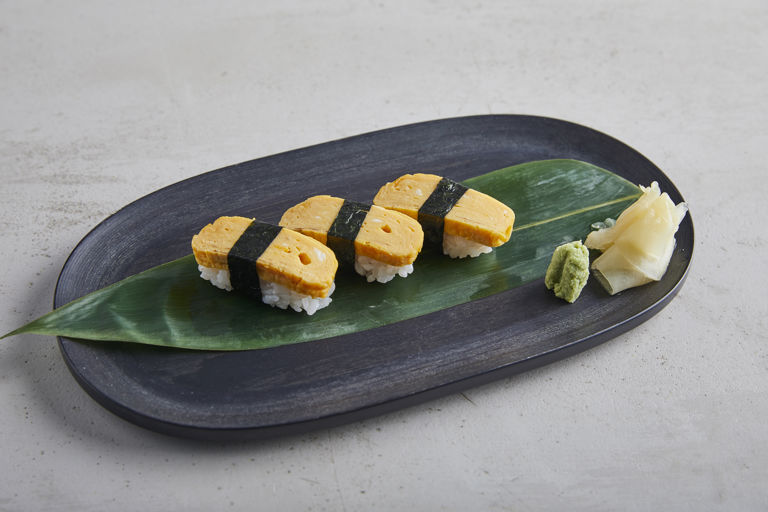Tamago nigiri

- medium
- Makes 10
- 60 minutes
While sushi is often associated with fish, Hideki Hiwatashi's tamago nigiri recipe shows that vegetarians can also enjoy the process of making perfectly-formed nigiri. Tamagoyaki is a traditional Japanese omelette, made by creating multiple thin layers of egg – a traditional tamagoyaki pan will make this process easier, but you can use a small frying pan instead, if preferred. This recipe makes more sushi rice than is needed, but you can use any excess to make Hideki's futomaki or sabazushi.
First published in 2018
discover more:
Ingredients
Metric
Imperial
Tamagoyaki
- 3 medium eggs, weighing approx. 150g
- 30g of water
- 20g of mirin
- 4g of usukuchi soy sauce, (light soy sauce)
- 1 dash of oil
Sushi rice (makes approx. 500g)
- 250g of sushi rice
- 300ml of water
- 1 small piece of kombu, approx. 3x3cm
Sushi vinegar (for 500g cooked rice)
- 30ml of rice vinegar
- 8g of salt
- 18g of sugar
- 1 small piece of kombu, approx. 3x3cm
To serve
- 1/2 nori sheet, cut into 10 1x10cm strips
- sushi ginger
- wasabi paste
SAVE RECIPE
Equipment
- Tamagoyaki pan
Method
1
To make the sushi rice, place the rice in a bowl and cover with water. Stir the rice using your fingers until the water turns a milky white colour. Drain in a colander and return the rice to the bowl. Repeat this washing and draining process four or five times, until the water is clear
- 250g of sushi rice
2
At this point, place the rice in the bowl, cover with water and leave to soak for 20 minutes
3
Drain the rice and add to a pan with the 300ml of water and small piece of kombu. Place a lid on the pan and cook over a high heat for 5 minutes, then reduce the heat and cook for another 20 minutes
- 1 small piece of kombu, approx. 3x3cm
- 300ml of water
4
While the rice is cooking, make the sushi vinegar by placing all the ingredients in a small pan and heating until the sugar and salt have dissolved. Keep the vinegar warm
- 1 small piece of kombu, approx. 3x3cm
- 30ml of rice vinegar
- 8g of salt
- 18g of sugar
5
When the rice is cooked, place it in a mixing bowl. While it and the sushi vinegar are still hot, add the sushi vinegar to the rice, cutting into the rice using the side of the paddle to avoid breaking too many grains
6
When the vinegar is incorporated, transfer the rice to a plate or tray, top with a damp sheet of kitchen paper and set aside to cool
7
To make the tamagoyaki, crack the eggs into a bowl and add the water, mirin, and soy sauce, whisking to combine
- 4g of usukuchi soy sauce, (light soy sauce)
- 3 medium eggs, weighing approx. 150g
- 30g of water
- 20g of mirin
8
Add a dash of oil to the pan and place over a medium-high heat. Once hot, Add a few spoonfuls of the egg mixture, tipping the pan to create an even layer
- 1 dash of oil
9
Once the layer is firm (but not completely set) carefully roll up the layer of egg using chopsticks and a flipping motion, until the omelette is fully rolled up. Spoon in more egg mixture, and once again allow to set before rolling the egg to create another layer
10
Repeat until you have four layers in total. It is important to leave the egg layers a little undercooked before rolling so that all the layers stick together
11
Transfer the omelette to a bamboo mat and form the mat around the omelette to create a nice neat shape. Allow to cool
12
When ready to serve, remove the tamago from the mat and cut into even slices
13
Moisten your hands and take a small ball of sushi rice, approximately 15g in weight
14
Place the ball on a slice of the omelette
15
Use your fingers to shape the rice into the same size as the slice of omelette. Repeat to make more nigiri
16
Fasten the omelette in place using a small strip of nori and serve with sushi ginger and wasabi paste
- wasabi paste
- 1/2 nori sheet, cut into 10 1x10cm strips
- sushi ginger
Get in touch
Please sign in or register to send a comment to Great British Chefs.

